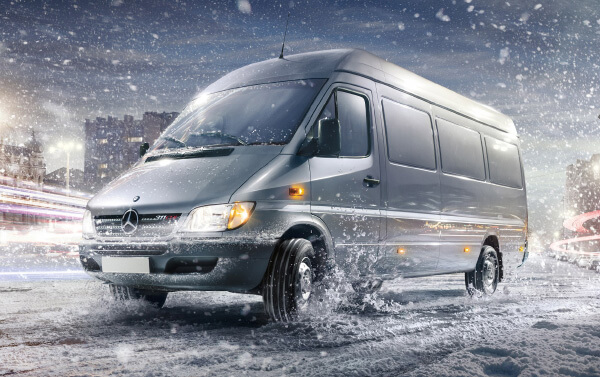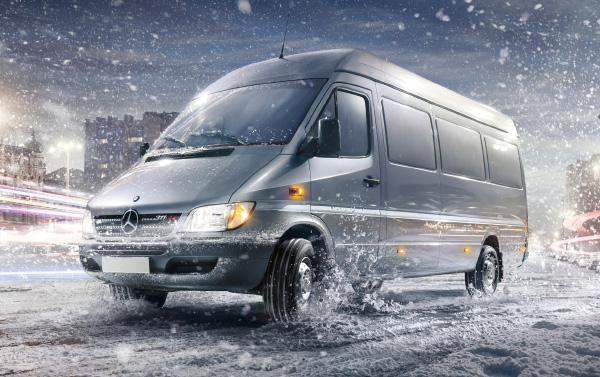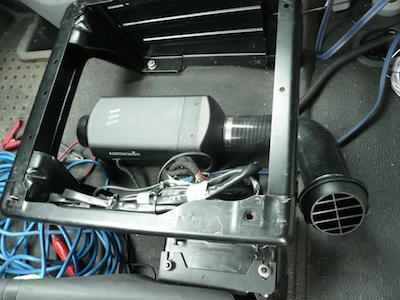Truck Topics

Air Heater Systems for Expedite Cargo Vans
 From November through March, it can get really cold in certain parts of the country, especially for expediters who operate cargo vans. That’s because there’s a lot of air space inside the van, often with insufficient insulation to retain heat. So, if the outside temperature is sub zero, and you’re inside the van waiting on your next load, you may be tempted to keep the engine running and the heater blowing.
From November through March, it can get really cold in certain parts of the country, especially for expediters who operate cargo vans. That’s because there’s a lot of air space inside the van, often with insufficient insulation to retain heat. So, if the outside temperature is sub zero, and you’re inside the van waiting on your next load, you may be tempted to keep the engine running and the heater blowing.
But idling the engine to stay warm is expensive and, in many cases, illegal.
According to the U.S. Department of Energy, one hour of idle consumes anywhere from 0.5 to over one gallon of fuel per hour, depending on vehicle class and engine type.
Therefore, if you idle your van eight hours per day, at a rate of 0.5 gallons of fuel per hour (which is conservative) – that’s four gallons of fuel wasted per day.
Now, let’s assume that during the cold months of the year you operate the vehicle 100 days (20 weeks multiplied by five days per week).
At four gallons per day and $3.55 per gallon for diesel (the national average according to AAA’s Fuel Gauge Report as of press time), that’s $1,420 squandered each winter through unnecessary engine idling.
 Engine idle is not only expensive from a fuel-cost perspective but also in terms of maintenance expenses. This is because idling increases engine hours, which leads to premature component wear and shorter overall vehicle life.
Engine idle is not only expensive from a fuel-cost perspective but also in terms of maintenance expenses. This is because idling increases engine hours, which leads to premature component wear and shorter overall vehicle life.
Also, there’s the risk of getting fined in areas where anti-idle laws are in effect. For example, in California, idling for more than five minutes is prohibited, except for certain exemptions, such as running the engine to power hydraulic equipment (for dump trucks, aerial platforms, etc.). Fines start at $300 and can be as much as $1,000 per day.
In fact, more than half of the states and numerous local governments in the U.S. have anti-idle laws in place, according to the American Transportation Research Institute. To find out what state and municipal idling regulations apply to the areas you serve, visit www.atri-online.org.
So, how can stay warm in your expedite van without burning up your cash reserves?
Fuel-Operated Air Heater Systems
A growing number of expediters are turning to fuel-operated air heaters, which use a vehicle’s existing dedicated fuel source (gasoline, diesel, or alternative fuel), while operating independent of the engine. This way, drivers can heat their vans in frigid climates without idling and wasting fuel.
The two key players in the air heater market are Espar and Webasto. The models suited for cargo van applications include Espar’s Airtronic and Webasto Air Top product lines.
What are the advantages of air heater systems?
Convenience. Since the air heater is tied into the vehicle’s primary fuel source, you don’t have to worry about maintaining sufficient fuel levels for a separate auxiliary power unit (APU) or replacing propane canisters (as with Mr. Heater Portable Buddy heaters). Quiet operation. Air heater systems run much quieter than those powered by diesel APUs or generators, creating a better environment for restful sleep. Fuel savings. Air heaters consume about one gallon of fuel every 20 to 24 hours, compared to engine idling, which burns about one gallon of fuel every one to two hours. Maximum comfort. With an integrated fan, air heaters are able to circulate warm air throughout the vehicle, unlike most portable propane and electric heaters that have a limited heat radius.
Preventive Maintenance for Air Heaters
What maintenance is required to keep your van’s air heater in optimal condition? Espar recommends the following procedures for its Airtronic units:
Operate the heater for a minimum of 20 minutes each month. Remove and inspect the glow pin for carbon build up. Clean the atomizer screen to remove any carbon build up, making sure the vent hole is open. Inspect the ducting and check the air intake screen and air outlet for blockage. Inspect combustion air intake and exhaust for blockage. Run your heater and check for proper operation during regular preventative maintenance throughout the year. Maintain your batteries and all electrical connections. With insufficient electrical power the heater will not start. Low and high voltage cutouts will shut the heater down automatically. Use fuel suitable for the climate (see engine manufacturers recommendations).
Source: Espar of Michigan
The downside to air heaters is the relatively high upfront cost, ranging from $1,600 to $2,400 installed, depending on the model and heating capacity. But Ray Lawrence, president of Espar of Michigan, says that air heaters can pay for themselves within the first winter through fuel cost savings.
“The air heaters allow van operators to turn their engine off and run on a fraction of the fuel the engine would operate on,†says Lawrence.
For example, Lawrence says the Espar gasoline model (Airtronic B2) burns about .02 gallons an hour, compared to one-half to one gallon per hour consumed by idling.
Run the numbers to determine what the payback period could be for your application.
Air Heater Selection and Configuration
What should you consider when selecting the right air heater system for your van? Use these three questions as your guide.
1. What fuel does your van use – gas, diesel, or alternative fuel?
The answer to this question dictates which model is appropriate for your van. For example, Espar’s Airtronic models are designated by “D2†or “D4†for diesel, “B2†or “B4†for gasoline, and “NG†for natural gas vans. With the Webasto product line, the Air Top 2000 ST D is compatible with diesel and biodiesel (B5 and B20), while the Air Top 2000 ST B is powered by gasoline.
2. Does the van have a sleeper unit?
This determines the size heater you need. If you have a sleeper unit in your van, Lawrence recommends the smaller air heater (such as Espar’s Airtronic B2 or D2). But if there’s no sleeper and the van’s cargo area is open, you should select the larger heater (Airtronic B4 or D4).
This is because an “open van†has much more air space to heat inside the vehicle, compared to a van with a sleeper, which has cabinetry and other components that serve as an insulated partition, making the overall air space smaller.
They key is to select the optimal heating capacity for the application. “Don’t skimp. If you’re operating a van without a sleeper and choose the smaller heater, you’ll be disappointed,†says Lawrence. “You might think, ‘Well, I’ll be ok with the small unit.’ But at 20-degrees below zero in North Dakota with the wind blowing 50 mph, you’ll be uncomfortable. While 7000 BTUs generated by the small heater may sound like a lot of heat, I can tell you that at sub-zero temperatures, it’s not enough to do the job.â€
3. Do you need an auxiliary battery?
Even though air heaters are powered primarily by gasoline or diesel fuel, they still draw a small amount of power from the vehicle battery. So, if the heater must operate continuously over extended periods (say, more than one day), this may drain the battery completely, leaving you without sufficient power to start the van.
“You don't have to have an auxiliary battery, but we recommend it for most expedite applications,†says Lawrence. “This is because, in the expediting world, you’re not just sitting in your van for five to six hours. You could easily sit for two days waiting on a load. You’re having to play this game of starting the engine every so often to keep the battery from draining completely. But, if you fall asleep and forget to start the van to recharge the battery, you’ll wake up and can’t get going because the battery is drained. That extra battery will give you peace of mind.â€
The Bottom Line
During those harsh winter months, it can be a challenge to stay warm in a cargo van. A fuel-operated air heater enables you to achieve a comfortable van temperature in the coldest climates, without idling the engine. This way, you can cut fuel costs, comply with anti-idle laws, protect the environment, and put more profit into your pocket.
